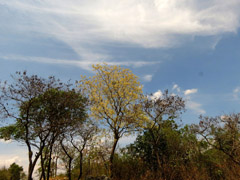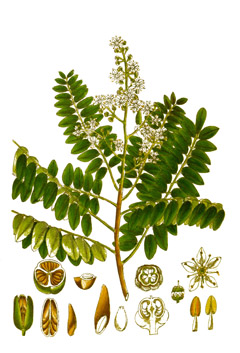 |
|
https://edibleplants.org/ |
 |
| https://edibleplants.org/ |
Translate this page:
Summary
Chloroxylon swietenia or commonly known as East Indian Stainwood is a tropical , medium-sized deciduous tree native to southern India, Madagascar, and Sri Lanka. It grows up to 20 m in height. The leaves are pinnate, the bark is slightly corky and thick, the flowers are small, creamy white, and the fruits are oblong three-segmented capsules. Most plant parts are used in traditional medicine in India. Essential oil obtained from the leaves and stems have anti-bacterial and anti-fungal properties. Dried leaves can be used for pains while crushed leaves for the treatment of wounds, snakebites, and rheumatism. Leaves and roots can be made into paste then taken internally or applied externally as relieve from headache. The seed yields oil. The wood is heavy, hard, durable, and used as decorative timber and in heavy construction, agricultural equipment, boat building, and railway sleepers. It is, in addition, used as fuel wood.
Physical Characteristics

 Chloroxylon swietenia is a deciduous Tree growing to 18 m (59ft) by 18 m (59ft) at a fast rate.
Chloroxylon swietenia is a deciduous Tree growing to 18 m (59ft) by 18 m (59ft) at a fast rate.
See above for USDA hardiness. It is hardy to UK zone 10.
Suitable for: light (sandy), medium (loamy) and heavy (clay) soils, prefers well-drained soil and can grow in nutritionally poor soil. Suitable pH: mildly acid, neutral and basic (mildly alkaline) soils and can grow in very acid and very alkaline soils.
It cannot grow in the shade. It prefers moist soil and can tolerate drought.
UK Hardiness Map
US Hardiness Map
Synonyms
Chloroxylon chloroxylon (Roxb.) Huth [Invalid]. Swietenia chloroxylon Roxb.
Plant Habitats
Edible Uses
Edible Parts: Oil
Edible Uses: Oil
The seeds contain 16% non-drying oil[ 299 ] which is probably inedible. See medicinal uses below.
References More on Edible Uses
Medicinal Uses
Plants For A Future can not take any responsibility for any adverse effects from the use of plants. Always seek advice from a professional before using a plant medicinally.
Antiasthmatic Antibacterial Antifungal Antirheumatic Astringent Febrifuge Malaria Parasiticide
In India most plant parts are used in traditional medicine. Research has shown the presence of various medically active substances in the plant. Coumarins and quinolinone alkaloids have been identified in the stem bark[ 299 ]. Coumarins, and alkaloid and 2,4-dihydroxy-5-prenycinnamic acid are found in the heartwood[ 299 ]. An essential oil in the leaves contains the terpenes limonene, germacrene D, geijerene, pregeijerene, trans-_-ocimene and methyl eugenol[ 299 ]. Both the leaf and the stem oils exhibit moderate to strong activities against a panel of bacteria and fungi[ 299 ]. The essential oil from the leaves and stems, plus several isolated compounds, display significant mosquitocidal activity by fumigation against Aedes aegypti, Anopheles gambiae and Culex quinquefasciatus, as well as activity against tobacco cutworm, Spodoptera litura[ 299 ]. Methanol extracts of the dried leaves exhibit good analgesic activity[ 299 ]. The crushed leaves are applied externally to treat wounds, snakebites and rheumatism[ 299 ]. A paste of the leaves and roots is taken internally to treat headache and is applied to the forehead as a balm for the same purpose[ 299 ]. The root bark in milk is drunk to treat impotence[ 299 ]. A bark extract is considered astringent and taken to treat fever, chest pain and in a mixture with other plants to treat asthma[ 299 ]. In friction it is used to treat bruises and painful joints[ 299 ].
References More on Medicinal Uses
The Bookshop: Edible Plant Books
Our Latest books on Perennial Plants For Food Forests and Permaculture Gardens in paperback or digital formats.

Edible Tropical Plants
Food Forest Plants for Hotter Conditions: 250+ Plants For Tropical Food Forests & Permaculture Gardens.
More

Edible Temperate Plants
Plants for Your Food Forest: 500 Plants for Temperate Food Forests & Permaculture Gardens.
More

More Books
PFAF have eight books available in paperback and digital formats. Browse the shop for more information.
Shop Now
Other Uses
Containers Essential Fuel Furniture Oil Parasiticide Wood
Other uses rating: High (4/5). Other Uses: The seeds contain 16% non-drying oil[ 299 ]. The wood is heavy, strong and hard, it has a slight pleasant fragrance when freshly cut. The heartwood is cream-coloured to golden yellow, darkening to brown with age; it is not clearly demarcated from the slightly paler sapwood. The grain is usually interlocked or wavy, texture fine and even. The wood is often striped or mottled, and remarkably lustrous. Dark gum veins are a common defect, as they are liable to develop into splits. The wood is difficult to work with hand tools and moderately hard to saw and machine, with a moderate to severe blunting effect on cutting tools. In planing a cutting angle of 15? is required to avoid tearing. A neat finishing makes it possible to obtain a perfectly polished surface and a beautiful glazed effect. Boring operations are reported to be rather difficult, and the wood requires to be held firmly in boring operations to prevent chattering. Preboring is recommended in nailing and screwing, but nail-holding and screw-holding properties are rated as good. The wood turns and stains well, but is difficult to glue[ 299 ]. The heartwood is rated as highly resistant to attack by all types of fungi, but in India it is reported to possess little resistance to attack by termites. It is also susceptible to attack by marine borers, and to a lesser extent by pinhole borers and longhorn beetles. The sapwood is not susceptible to Lyctus borers. The heartwood is extremely resistant to preservative treatment. The wood is reported to cause skin irritation[ 299 ]. A decorative timber, it is used for furniture, panelling, pattern making, interior trim, cabinet work, flooring, boxes, crates, interior joinery, carvings, toys, musical instruments and luxury goods. It is made into decorative veneer, which is, however, unsuitable for plywood manufacture because of its weight. Because of its strength it is also used for heavy construction, railway sleepers, boat building and agricultural equipment[ 299 ]. The wood is also used as fuel wood[ 299 ].
Special Uses
Coppice
References More on Other Uses
Cultivation details
A plant of the lowland moist tropics, where it is found at elevations up to 450 metres. It grows best in areas where annual daytime temperatures are within the range 30 - 40°c, but can tolerate 10 - 47°c[ 418 ]. It prefers a mean annual rainfall in the range 1,000 - 1,500mm, but tolerates 750 - 1,900mm[ 418 ]. Grows best in a sunny position[ 418 ]. Succeeds in most soils that are well-drained[ 418 ]. Prefers a pH in the range 6 - 7, tolerating 5 - 7.8[ 418 ]. Established plants are drought tolerant[ 418 ]. The tree has shown good growth rates in Nigeria[ 299 ]. It coppices well[ 299 ]. The plant is susceptible to fire damage[ 418 ]. In India the tree is an alternative food-plant for the caterpillars of Papilio demoleus, a pest of Citrus spp[ 299 ].
References Carbon Farming Information and Carbon Sequestration Information
Temperature Converter
Type a value in the Celsius field to convert the value to Fahrenheit:
Fahrenheit:
The PFAF Bookshop
Plants For A Future have a number of books available in paperback and digital form. Book titles include Edible Plants, Edible Perennials, Edible Trees,Edible Shrubs, Woodland Gardening, and Temperate Food Forest Plants. Our new book is Food Forest Plants For Hotter Conditions (Tropical and Sub-Tropical).
Shop Now
Plant Propagation
Seed
Other Names
If available other names are mentioned here
Chloroxylon swietenia or commonly known as East Indian Stainwood.
Ceylon Satinwood, East Indian Satinwood, Buruta ¥ Hindi: Bhirra, Bhivia, Dhoura, Girya ¥ Marathi: Behru, Halda, Bheria, Hulda ¥ Tamil: Vaaimaram or porasu, Mammarai, Porinja maram ¥ Malayalam: Varimaram: Telugu: billu, billydu, billudu, bella Kannada: bittulla, huragalu, hurihuli, masula Oriya: bheru gatcho ¥ Sanskrit: bhillotaka, bimbilota
Native Range
TROPICAL ASIA: India (south), Sri Lanka
Weed Potential
Right plant wrong place. We are currently updating this section.
Please note that a plant may be invasive in one area but may not in your area so it's worth checking.
None Known
Conservation Status
IUCN Red List of Threatened Plants Status : Chloroxylon swietenia (East Indian Satinwood)

Growth: S = slow M = medium F = fast. Soil: L = light (sandy) M = medium H = heavy (clay). pH: A = acid N = neutral B = basic (alkaline). Shade: F = full shade S = semi-shade N = no shade. Moisture: D = dry M = Moist We = wet Wa = water.
Now available:
Food Forest Plants for Mediterranean Conditions
350+ Perennial Plants For Mediterranean and Drier Food Forests and Permaculture Gardens.
[Paperback and eBook]
This is the third in Plants For A Future's series of plant guides for food forests tailored to
specific climate zones. Following volumes on temperate and tropical ecosystems, this book focuses
on species suited to Mediterranean conditions—regions with hot, dry summers and cool, wet winters,
often facing the added challenge of climate change.
Read More
Expert comment
Author
DC.
Botanical References
Links / References
For a list of references used on this page please go here
A special thanks to Ken Fern for some of the information used on this page.
Readers comment
| Add a comment |
|
If you have important information about this plant that may help other users please add a comment or link below. Only comments or links that are felt to be directly relevant to a plant will be included. If you think a comment/link or information contained on this page is inaccurate or misleading we would welcome your feedback at [email protected]. If you have questions about a plant please use the Forum on this website as we do not have the resources to answer questions ourselves.
* Please note: the comments by website users are not necessarily those held by PFAF and may give misleading or inaccurate information.
To leave a comment please Register or login here All comments need to be approved so will not appear immediately.
|
Subject : Chloroxylon swietenia
|
|
|
|